Australian Taxation Law: John's Property and Business Tax Analysis
VerifiedAdded on 2023/01/20
|6
|1509
|47
Case Study
AI Summary
This case study analyzes the Australian tax implications for John, a self-employed architect, regarding his property used for business. John purchased a house, using 15% of it as a home office. The analysis covers rental income, deductions for property expenditures, and capital gains tax. It examines his eligibility for the First Home Savers Account, tax implications on loan interest, and capital gain tax. The assessment includes deductions for home office expenses, car usage, and expenses related to the work area. The study explores the tax consequences of a council fine, expenses for decorating the work area, and the sale of an antique desk. The final analysis calculates John's total tax liability, considering all relevant deductions and capital gains, and the tax implications of his car expenses.
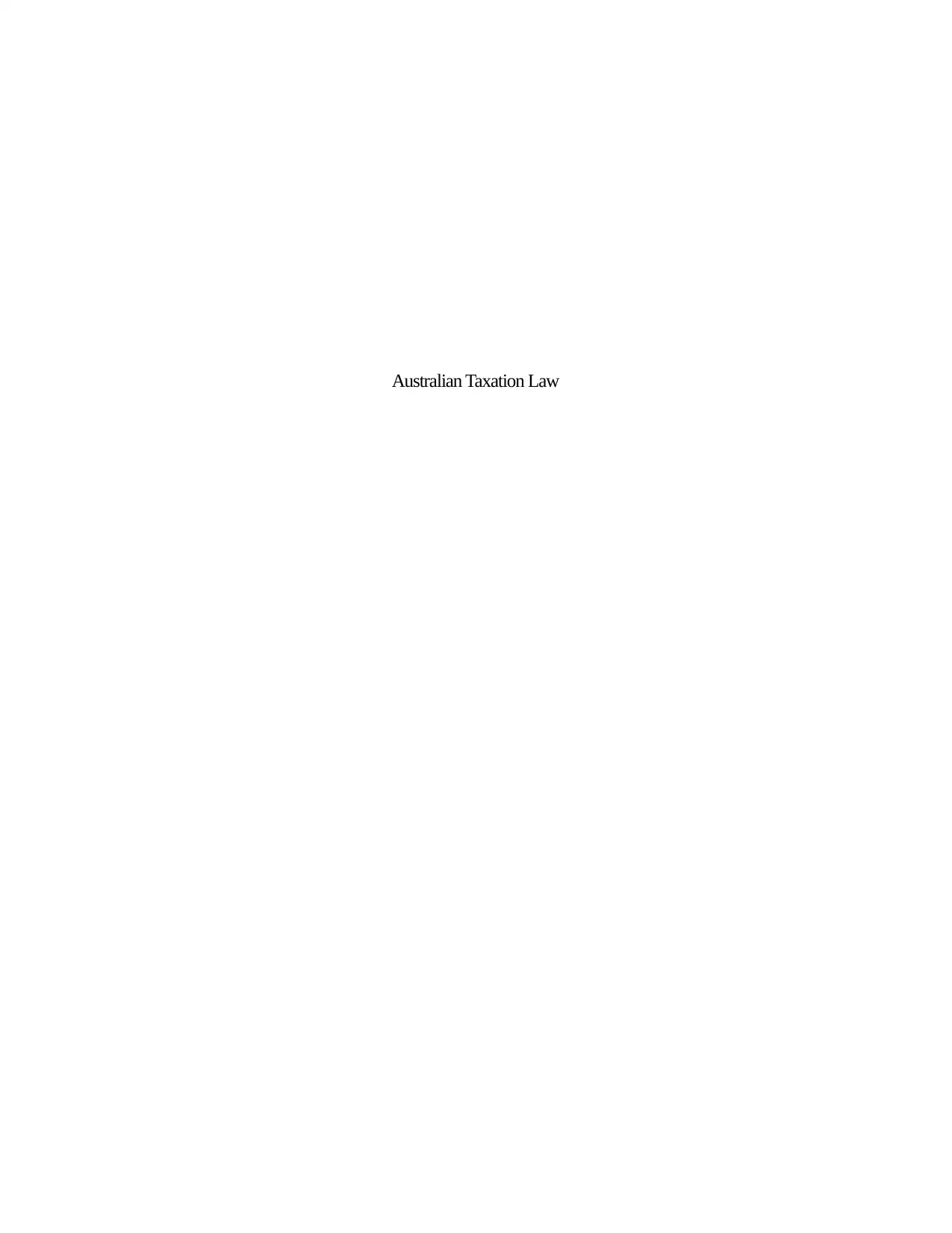
Australian Taxation Law
Paraphrase This Document
Need a fresh take? Get an instant paraphrase of this document with our AI Paraphraser
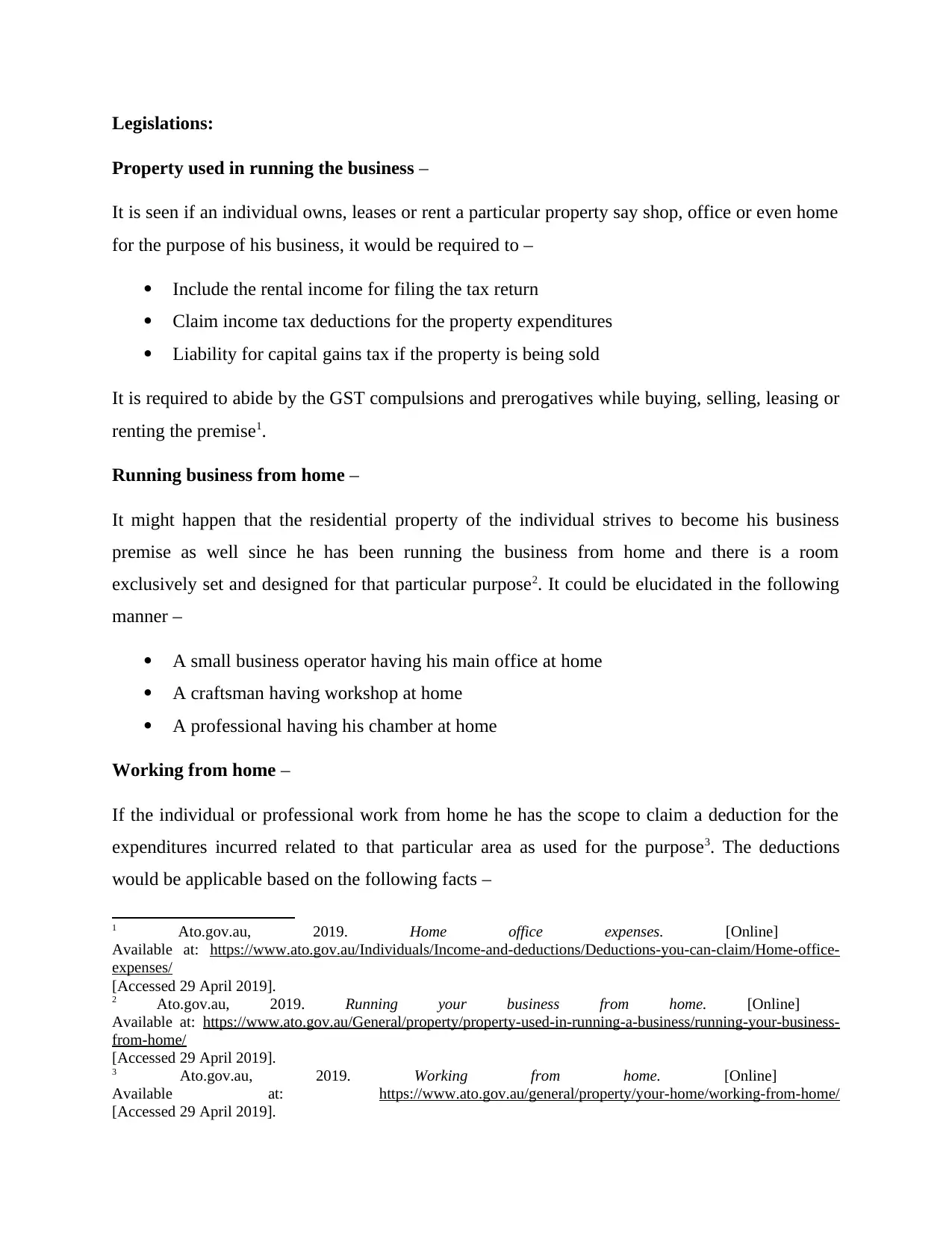
Legislations:
Property used in running the business –
It is seen if an individual owns, leases or rent a particular property say shop, office or even home
for the purpose of his business, it would be required to –
Include the rental income for filing the tax return
Claim income tax deductions for the property expenditures
Liability for capital gains tax if the property is being sold
It is required to abide by the GST compulsions and prerogatives while buying, selling, leasing or
renting the premise1.
Running business from home –
It might happen that the residential property of the individual strives to become his business
premise as well since he has been running the business from home and there is a room
exclusively set and designed for that particular purpose2. It could be elucidated in the following
manner –
A small business operator having his main office at home
A craftsman having workshop at home
A professional having his chamber at home
Working from home –
If the individual or professional work from home he has the scope to claim a deduction for the
expenditures incurred related to that particular area as used for the purpose3. The deductions
would be applicable based on the following facts –
1 Ato.gov.au, 2019. Home office expenses. [Online]
Available at: https://www.ato.gov.au/Individuals/Income-and-deductions/Deductions-you-can-claim/Home-office-
expenses/
[Accessed 29 April 2019].
2 Ato.gov.au, 2019. Running your business from home. [Online]
Available at: https://www.ato.gov.au/General/property/property-used-in-running-a-business/running-your-business-
from-home/
[Accessed 29 April 2019].
3 Ato.gov.au, 2019. Working from home. [Online]
Available at: https://www.ato.gov.au/general/property/your-home/working-from-home/
[Accessed 29 April 2019].
Property used in running the business –
It is seen if an individual owns, leases or rent a particular property say shop, office or even home
for the purpose of his business, it would be required to –
Include the rental income for filing the tax return
Claim income tax deductions for the property expenditures
Liability for capital gains tax if the property is being sold
It is required to abide by the GST compulsions and prerogatives while buying, selling, leasing or
renting the premise1.
Running business from home –
It might happen that the residential property of the individual strives to become his business
premise as well since he has been running the business from home and there is a room
exclusively set and designed for that particular purpose2. It could be elucidated in the following
manner –
A small business operator having his main office at home
A craftsman having workshop at home
A professional having his chamber at home
Working from home –
If the individual or professional work from home he has the scope to claim a deduction for the
expenditures incurred related to that particular area as used for the purpose3. The deductions
would be applicable based on the following facts –
1 Ato.gov.au, 2019. Home office expenses. [Online]
Available at: https://www.ato.gov.au/Individuals/Income-and-deductions/Deductions-you-can-claim/Home-office-
expenses/
[Accessed 29 April 2019].
2 Ato.gov.au, 2019. Running your business from home. [Online]
Available at: https://www.ato.gov.au/General/property/property-used-in-running-a-business/running-your-business-
from-home/
[Accessed 29 April 2019].
3 Ato.gov.au, 2019. Working from home. [Online]
Available at: https://www.ato.gov.au/general/property/your-home/working-from-home/
[Accessed 29 April 2019].
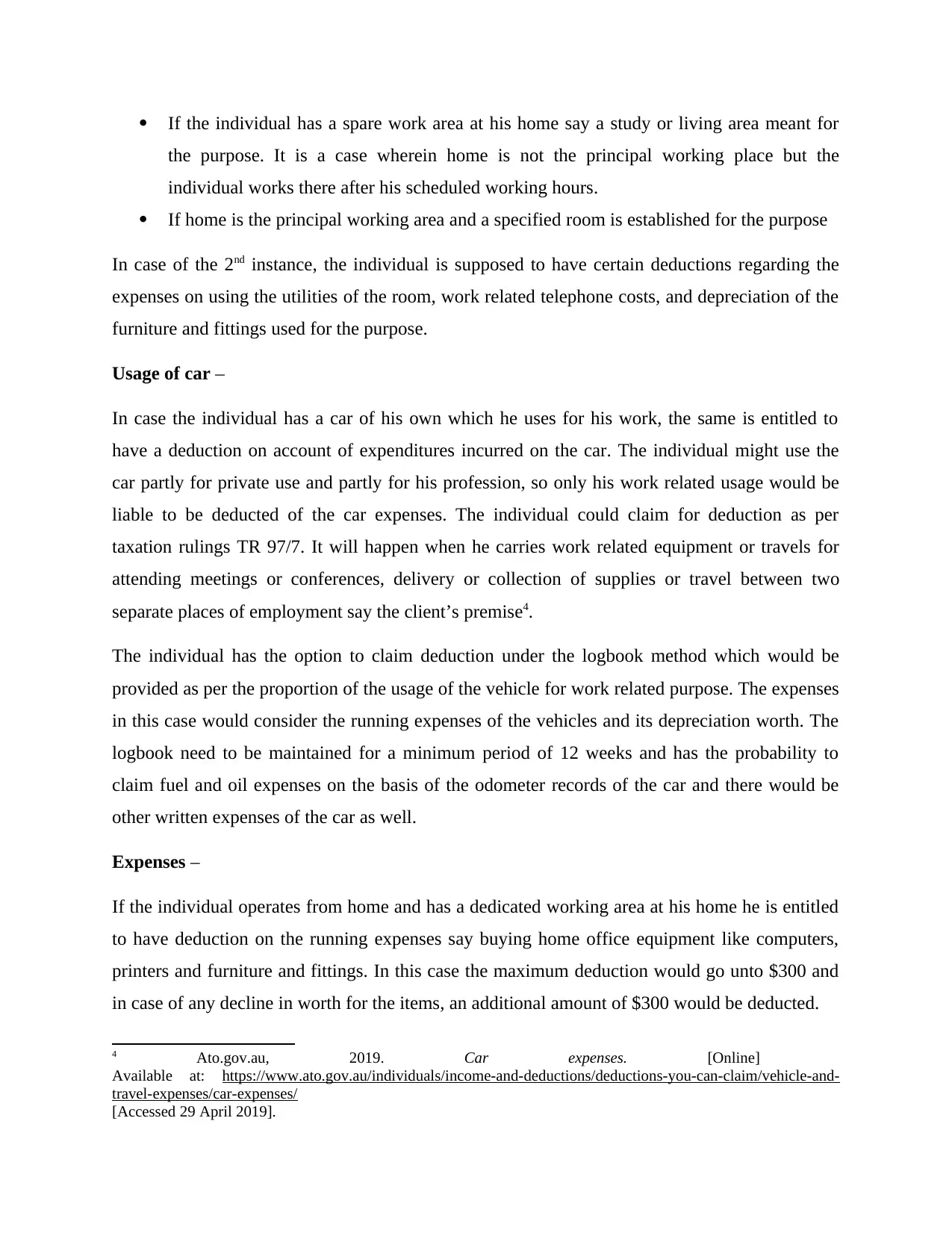
If the individual has a spare work area at his home say a study or living area meant for
the purpose. It is a case wherein home is not the principal working place but the
individual works there after his scheduled working hours.
If home is the principal working area and a specified room is established for the purpose
In case of the 2nd instance, the individual is supposed to have certain deductions regarding the
expenses on using the utilities of the room, work related telephone costs, and depreciation of the
furniture and fittings used for the purpose.
Usage of car –
In case the individual has a car of his own which he uses for his work, the same is entitled to
have a deduction on account of expenditures incurred on the car. The individual might use the
car partly for private use and partly for his profession, so only his work related usage would be
liable to be deducted of the car expenses. The individual could claim for deduction as per
taxation rulings TR 97/7. It will happen when he carries work related equipment or travels for
attending meetings or conferences, delivery or collection of supplies or travel between two
separate places of employment say the client’s premise4.
The individual has the option to claim deduction under the logbook method which would be
provided as per the proportion of the usage of the vehicle for work related purpose. The expenses
in this case would consider the running expenses of the vehicles and its depreciation worth. The
logbook need to be maintained for a minimum period of 12 weeks and has the probability to
claim fuel and oil expenses on the basis of the odometer records of the car and there would be
other written expenses of the car as well.
Expenses –
If the individual operates from home and has a dedicated working area at his home he is entitled
to have deduction on the running expenses say buying home office equipment like computers,
printers and furniture and fittings. In this case the maximum deduction would go unto $300 and
in case of any decline in worth for the items, an additional amount of $300 would be deducted.
4 Ato.gov.au, 2019. Car expenses. [Online]
Available at: https://www.ato.gov.au/individuals/income-and-deductions/deductions-you-can-claim/vehicle-and-
travel-expenses/car-expenses/
[Accessed 29 April 2019].
the purpose. It is a case wherein home is not the principal working place but the
individual works there after his scheduled working hours.
If home is the principal working area and a specified room is established for the purpose
In case of the 2nd instance, the individual is supposed to have certain deductions regarding the
expenses on using the utilities of the room, work related telephone costs, and depreciation of the
furniture and fittings used for the purpose.
Usage of car –
In case the individual has a car of his own which he uses for his work, the same is entitled to
have a deduction on account of expenditures incurred on the car. The individual might use the
car partly for private use and partly for his profession, so only his work related usage would be
liable to be deducted of the car expenses. The individual could claim for deduction as per
taxation rulings TR 97/7. It will happen when he carries work related equipment or travels for
attending meetings or conferences, delivery or collection of supplies or travel between two
separate places of employment say the client’s premise4.
The individual has the option to claim deduction under the logbook method which would be
provided as per the proportion of the usage of the vehicle for work related purpose. The expenses
in this case would consider the running expenses of the vehicles and its depreciation worth. The
logbook need to be maintained for a minimum period of 12 weeks and has the probability to
claim fuel and oil expenses on the basis of the odometer records of the car and there would be
other written expenses of the car as well.
Expenses –
If the individual operates from home and has a dedicated working area at his home he is entitled
to have deduction on the running expenses say buying home office equipment like computers,
printers and furniture and fittings. In this case the maximum deduction would go unto $300 and
in case of any decline in worth for the items, an additional amount of $300 would be deducted.
4 Ato.gov.au, 2019. Car expenses. [Online]
Available at: https://www.ato.gov.au/individuals/income-and-deductions/deductions-you-can-claim/vehicle-and-
travel-expenses/car-expenses/
[Accessed 29 April 2019].
⊘ This is a preview!⊘
Do you want full access?
Subscribe today to unlock all pages.

Trusted by 1+ million students worldwide
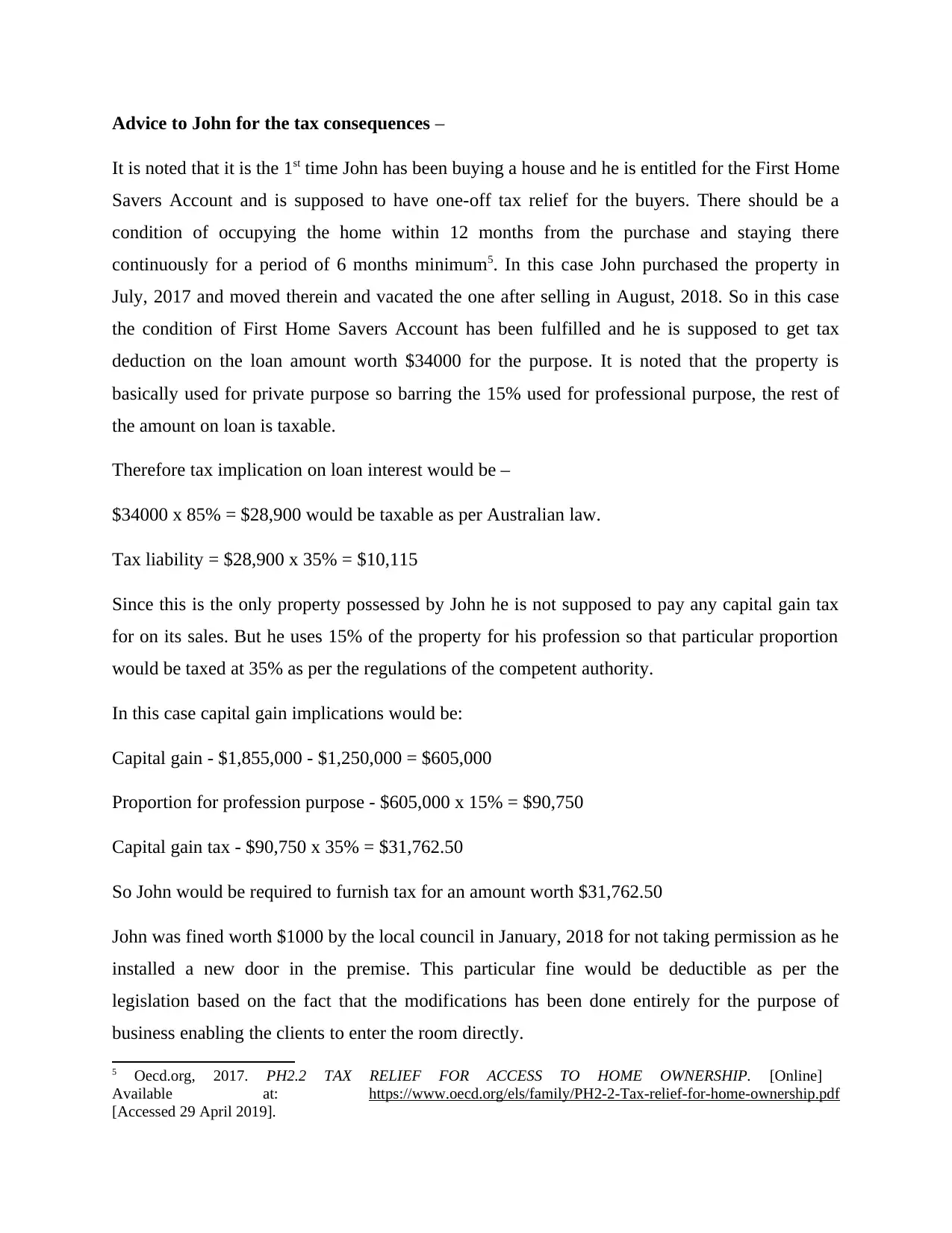
Advice to John for the tax consequences –
It is noted that it is the 1st time John has been buying a house and he is entitled for the First Home
Savers Account and is supposed to have one-off tax relief for the buyers. There should be a
condition of occupying the home within 12 months from the purchase and staying there
continuously for a period of 6 months minimum5. In this case John purchased the property in
July, 2017 and moved therein and vacated the one after selling in August, 2018. So in this case
the condition of First Home Savers Account has been fulfilled and he is supposed to get tax
deduction on the loan amount worth $34000 for the purpose. It is noted that the property is
basically used for private purpose so barring the 15% used for professional purpose, the rest of
the amount on loan is taxable.
Therefore tax implication on loan interest would be –
$34000 x 85% = $28,900 would be taxable as per Australian law.
Tax liability = $28,900 x 35% = $10,115
Since this is the only property possessed by John he is not supposed to pay any capital gain tax
for on its sales. But he uses 15% of the property for his profession so that particular proportion
would be taxed at 35% as per the regulations of the competent authority.
In this case capital gain implications would be:
Capital gain - $1,855,000 - $1,250,000 = $605,000
Proportion for profession purpose - $605,000 x 15% = $90,750
Capital gain tax - $90,750 x 35% = $31,762.50
So John would be required to furnish tax for an amount worth $31,762.50
John was fined worth $1000 by the local council in January, 2018 for not taking permission as he
installed a new door in the premise. This particular fine would be deductible as per the
legislation based on the fact that the modifications has been done entirely for the purpose of
business enabling the clients to enter the room directly.
5 Oecd.org, 2017. PH2.2 TAX RELIEF FOR ACCESS TO HOME OWNERSHIP. [Online]
Available at: https://www.oecd.org/els/family/PH2-2-Tax-relief-for-home-ownership.pdf
[Accessed 29 April 2019].
It is noted that it is the 1st time John has been buying a house and he is entitled for the First Home
Savers Account and is supposed to have one-off tax relief for the buyers. There should be a
condition of occupying the home within 12 months from the purchase and staying there
continuously for a period of 6 months minimum5. In this case John purchased the property in
July, 2017 and moved therein and vacated the one after selling in August, 2018. So in this case
the condition of First Home Savers Account has been fulfilled and he is supposed to get tax
deduction on the loan amount worth $34000 for the purpose. It is noted that the property is
basically used for private purpose so barring the 15% used for professional purpose, the rest of
the amount on loan is taxable.
Therefore tax implication on loan interest would be –
$34000 x 85% = $28,900 would be taxable as per Australian law.
Tax liability = $28,900 x 35% = $10,115
Since this is the only property possessed by John he is not supposed to pay any capital gain tax
for on its sales. But he uses 15% of the property for his profession so that particular proportion
would be taxed at 35% as per the regulations of the competent authority.
In this case capital gain implications would be:
Capital gain - $1,855,000 - $1,250,000 = $605,000
Proportion for profession purpose - $605,000 x 15% = $90,750
Capital gain tax - $90,750 x 35% = $31,762.50
So John would be required to furnish tax for an amount worth $31,762.50
John was fined worth $1000 by the local council in January, 2018 for not taking permission as he
installed a new door in the premise. This particular fine would be deductible as per the
legislation based on the fact that the modifications has been done entirely for the purpose of
business enabling the clients to enter the room directly.
5 Oecd.org, 2017. PH2.2 TAX RELIEF FOR ACCESS TO HOME OWNERSHIP. [Online]
Available at: https://www.oecd.org/els/family/PH2-2-Tax-relief-for-home-ownership.pdf
[Accessed 29 April 2019].
Paraphrase This Document
Need a fresh take? Get an instant paraphrase of this document with our AI Paraphraser
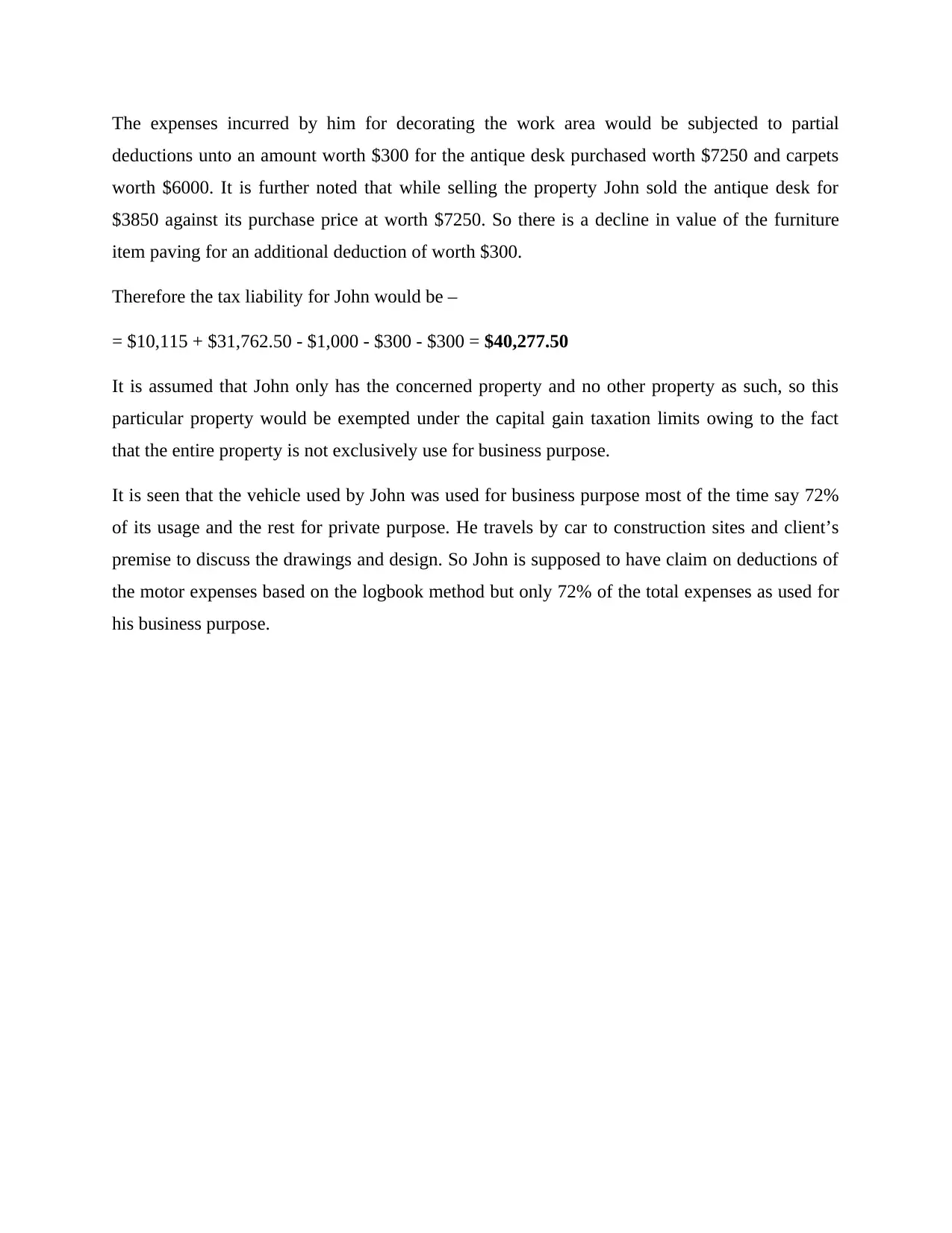
The expenses incurred by him for decorating the work area would be subjected to partial
deductions unto an amount worth $300 for the antique desk purchased worth $7250 and carpets
worth $6000. It is further noted that while selling the property John sold the antique desk for
$3850 against its purchase price at worth $7250. So there is a decline in value of the furniture
item paving for an additional deduction of worth $300.
Therefore the tax liability for John would be –
= $10,115 + $31,762.50 - $1,000 - $300 - $300 = $40,277.50
It is assumed that John only has the concerned property and no other property as such, so this
particular property would be exempted under the capital gain taxation limits owing to the fact
that the entire property is not exclusively use for business purpose.
It is seen that the vehicle used by John was used for business purpose most of the time say 72%
of its usage and the rest for private purpose. He travels by car to construction sites and client’s
premise to discuss the drawings and design. So John is supposed to have claim on deductions of
the motor expenses based on the logbook method but only 72% of the total expenses as used for
his business purpose.
deductions unto an amount worth $300 for the antique desk purchased worth $7250 and carpets
worth $6000. It is further noted that while selling the property John sold the antique desk for
$3850 against its purchase price at worth $7250. So there is a decline in value of the furniture
item paving for an additional deduction of worth $300.
Therefore the tax liability for John would be –
= $10,115 + $31,762.50 - $1,000 - $300 - $300 = $40,277.50
It is assumed that John only has the concerned property and no other property as such, so this
particular property would be exempted under the capital gain taxation limits owing to the fact
that the entire property is not exclusively use for business purpose.
It is seen that the vehicle used by John was used for business purpose most of the time say 72%
of its usage and the rest for private purpose. He travels by car to construction sites and client’s
premise to discuss the drawings and design. So John is supposed to have claim on deductions of
the motor expenses based on the logbook method but only 72% of the total expenses as used for
his business purpose.
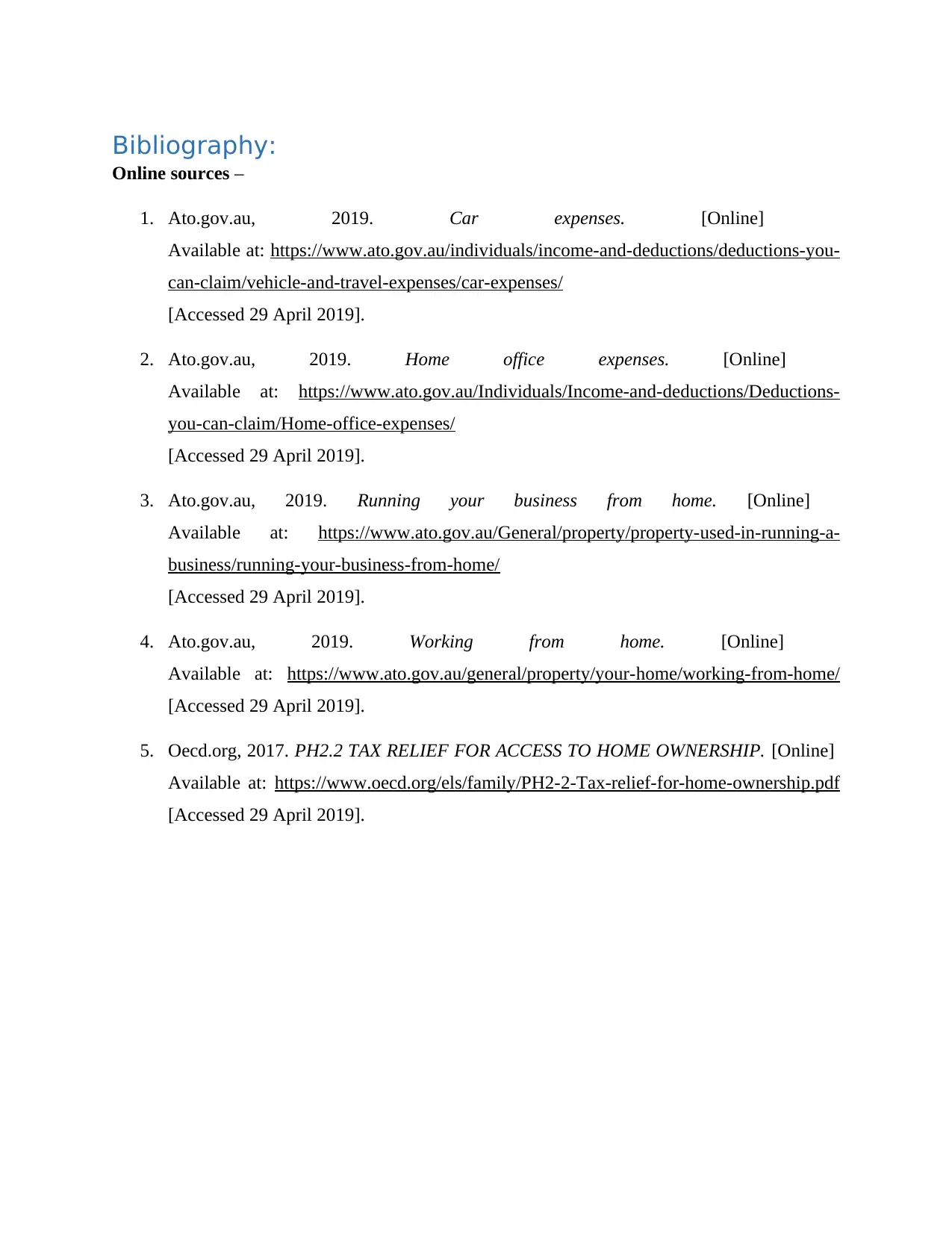
Bibliography:
Online sources –
1. Ato.gov.au, 2019. Car expenses. [Online]
Available at: https://www.ato.gov.au/individuals/income-and-deductions/deductions-you-
can-claim/vehicle-and-travel-expenses/car-expenses/
[Accessed 29 April 2019].
2. Ato.gov.au, 2019. Home office expenses. [Online]
Available at: https://www.ato.gov.au/Individuals/Income-and-deductions/Deductions-
you-can-claim/Home-office-expenses/
[Accessed 29 April 2019].
3. Ato.gov.au, 2019. Running your business from home. [Online]
Available at: https://www.ato.gov.au/General/property/property-used-in-running-a-
business/running-your-business-from-home/
[Accessed 29 April 2019].
4. Ato.gov.au, 2019. Working from home. [Online]
Available at: https://www.ato.gov.au/general/property/your-home/working-from-home/
[Accessed 29 April 2019].
5. Oecd.org, 2017. PH2.2 TAX RELIEF FOR ACCESS TO HOME OWNERSHIP. [Online]
Available at: https://www.oecd.org/els/family/PH2-2-Tax-relief-for-home-ownership.pdf
[Accessed 29 April 2019].
Online sources –
1. Ato.gov.au, 2019. Car expenses. [Online]
Available at: https://www.ato.gov.au/individuals/income-and-deductions/deductions-you-
can-claim/vehicle-and-travel-expenses/car-expenses/
[Accessed 29 April 2019].
2. Ato.gov.au, 2019. Home office expenses. [Online]
Available at: https://www.ato.gov.au/Individuals/Income-and-deductions/Deductions-
you-can-claim/Home-office-expenses/
[Accessed 29 April 2019].
3. Ato.gov.au, 2019. Running your business from home. [Online]
Available at: https://www.ato.gov.au/General/property/property-used-in-running-a-
business/running-your-business-from-home/
[Accessed 29 April 2019].
4. Ato.gov.au, 2019. Working from home. [Online]
Available at: https://www.ato.gov.au/general/property/your-home/working-from-home/
[Accessed 29 April 2019].
5. Oecd.org, 2017. PH2.2 TAX RELIEF FOR ACCESS TO HOME OWNERSHIP. [Online]
Available at: https://www.oecd.org/els/family/PH2-2-Tax-relief-for-home-ownership.pdf
[Accessed 29 April 2019].
⊘ This is a preview!⊘
Do you want full access?
Subscribe today to unlock all pages.

Trusted by 1+ million students worldwide
1 out of 6
Related Documents
Your All-in-One AI-Powered Toolkit for Academic Success.
+13062052269
info@desklib.com
Available 24*7 on WhatsApp / Email
![[object Object]](/_next/static/media/star-bottom.7253800d.svg)
Unlock your academic potential
Copyright © 2020–2025 A2Z Services. All Rights Reserved. Developed and managed by ZUCOL.




